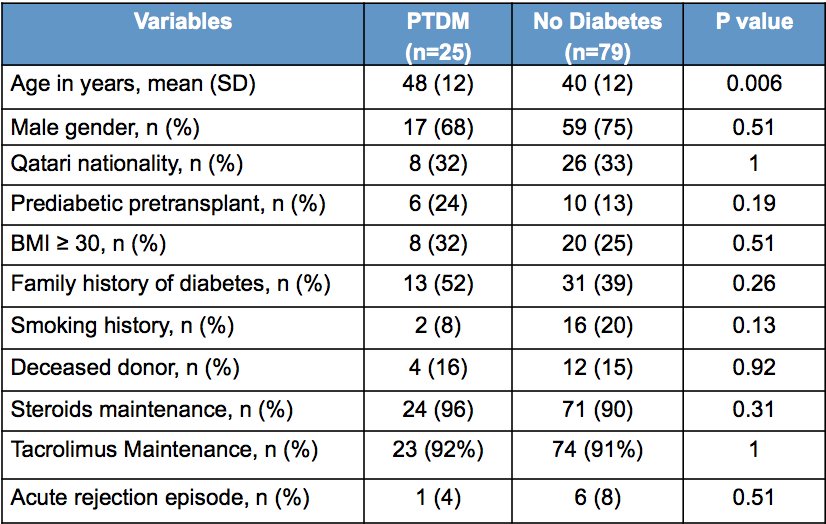Incidence and Risk Factors of Post Transplant Diabetes Mellitus in Kidney Transplant Recipients in Qatar
Mohamad Alkadi1, Shaefiq Thappy1, Essa Abuhelaiqa1, Jehan Mahmoud2, Mona Jarman2, Saifat Ullah Khan1, Faten Makableh2, Litty Mathew2, Ahmed Hamdi1, Muhammad Asim1, Omar Fituri1, Adel Aziz1, Awais Nauman1, Thangamani Muthukumar3, Hassan Al-Malki1.
1Medicine-Nephrology, Hamad Medical Corporation (HMC), Doha, Qatar; 2Surgery-Transplant, Hamad Medical Corporation, Doha, Qatar; 3Transplantation Medicine, New York Presbyterian Hospital-Weill Cornell Medical Center, New York, NY, United States
Introduction: Diabetes Mellitus is the leading cause of end stage renal disease. Post transplant diabetes mellitus (PTDM) increases the risk of cardiovascular disease and infection, reducing graft and patient survival. The aim of this study was to determine the incidence of PTDM and identify risk factors for development of PTDM in our kidney transplant population.\
Methods: Hamad Medical Corporation is the only hospital in Qatar that provides post transplantation care for kidney transplant recipients. Between January 1st, 2014 and January 1st, 2017, 187 adult patients were transplanted and were followed at our center. We excluded patients who had preexisting diabetes mellitus (n= 79) and those with post transplantation follow up for less than 6 months at our center (n= 4). PTDM was diagnosed if hemoglobin A1c, 3 months post transplantation, was equal to or higher than 6.5%. Multiple variables were assessed using univariate and multivariate logestic regression analysis to determine risk factors for PTDM development.
Results: Twenty five out of 104 kidney transplant recipients developed PTDM. The incidence of PTDM was 24%. Most PTDM cases were diagnosed within first year post transplantation (n= 22). None of the patients with PTDM had HCV infection. Hypomagnesemia could not be assessed as many patients did not have magnesium level checked within the first 3 months post transplantation. Of all variables studied, only age was found to be an independent risk factor for development of PTDM, using univariate and multivariate analysis. An increase in age by one year, increased the odds of NODAT by 5.6% [(95% CI: 1.3% to 10%), P= 0.01]. The results of univariate analysis are shown in the table below.

Conclusion: To our knowledge, this is the first study to determine incidence and risk factors for development of PTDM in kidney transplant patients in Qatar. The incidence of PTDM was high (24%) in our population and older age was the only independent risk factor of PTDM. We believe that close monitoring of elderly and adaptation of steroid-free immunosuppression regimen may be of worthy consideration in such group.
